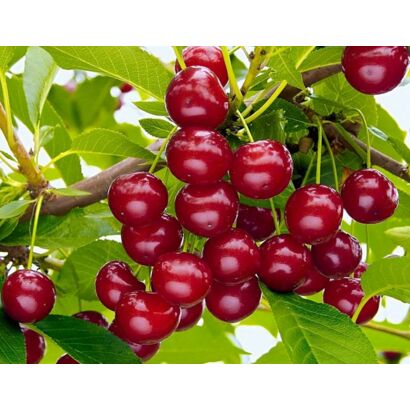Cherry Plentiful
Variety: self-fertile
Fruits: 2.5-3 gr., ruby.
Ripening period: late, extended
Yield: 10 kg/tree
Growing conditions: all regions
Selection: Ural
| Ripening period | Late-ripening variety |
| fruit size | Traditional varieties |
| Productivity: | high |
| Selection | Russia |
| planting material | Cherry |
The Izobilnaya cherry variety was bred by breeders of the Sverdlovsk Horticulture Breeding Station (Ural Agrarian Research Center) by free pollination of Michurin cherry varieties. In 1992, "Abundant" included in the State Register with permission to grow in almost all regions of the Russian Federation, including northern latitudes.
Dignity of the variety: winter hardiness, self-fertility, high yield, late flowering. Weaknesses: late extended ripening.
Characteristics of the variety
Shrub medium growing up to 2.5-3 m, with a compact, not very dense crown. The foliage is dark green and numerous. Plate – oval, smooth with serrated edges and a sharp tip. The flowers are white, goblet-shaped, collected in inflorescences of 4-7 pcs. Fruits are formed on annual growth and bouquet branches.
Fruits rounded, small, about 15 cm in diameter, weighing 2.5-3.0 g. Peel of ripe cherries – dark red, shiny, with a side seam. Pulp – red, tender, with pink juice. The bone separates weakly. Taste – sweet-sour. Evaluation of the appearance of berries – 4 points, taste – 3.8 out of 5. Cherries are consumed fresh, processed into jams, juices, etc.
Productivity is high, starting from the 3rd-4th season after planting the seedling. The plant reaches its peak productivity by 8-10 years of age. Flowering and fruit ripening later: in the first days of June and in the second half of August, respectively. Cherries ripen gradually, so you have to harvest in 2-3 stages. The life expectancy of a tree is up to 30 years, with periodic anti-aging pruning.
Destination. Cherry variety «Abundant» referred to as industrial crops. It is suitable for intensive type of cultivation, cultivation on industrial and amateur scales, ideal as a breeding resource. The fruits are resistant to cracking. Separation of cherries from the stalk – dry.
Immunity. The plant mcan be affected by coccomycosis, moniliosis, slimy sawfly, cherry aphids. Preventive treatment is required.
Growing conditions. Cherry variety «Abundant» – frost-resistant. Even in severe winters, buds and wood practically do not freeze out. Due to the late flowering of trees, spring frosts are not terrible for the future harvest. Also, the culture tolerates drought well, which makes it universal for cultivation in any climatic zone.
"Abundant" – self-fertile, for high yields it does not need "neighbors"; by cross-pollination.
Preparations
| Phase | Operation | Biopreparations | Comment |
|---|---|---|---|
| Pre-plant tillage | Disease treatment | SBT-Trichodermin TH82 | Fight against overwintering forms of pathogens 30-100 g/20 l of water per 1 weave |
| top dressing | SBT-Ekosoil | Stimulation of biological activity 50 g per 20 l of water / 1 weave |
|
| root formation | Disease treatment | SBT-Fitolek BS26 | Soaking the roots of seedlings Prevention of the development of a wide range of fungal diseases 60 g/10 l for 50 pcs. seedlings |
| SBT-Trichodermin TH82 | Prevention of the development of a wide range of fungal diseases. Soaking the roots of seedlings 60 g/10 l for 50 pcs |
||
| Bloom | Disease treatment | SBT-Trichodermin TH82 | Prevention of late blight, powdery mildew, root rot, gray mold, leaf spot 40 g/10 l per 100 m2 |
| SBT-Fitolek BS26 | Processing in the budding phase Prevention of powdery mildew, alternariosis, anthracnose, fomopsis, gray mold, curliness, septoria, tuberculariasis 40 g / 10 l per 1 weave |
||
| Pest control | SBT-Actaro E | Processing in the budding phase Control of pests weevils, bronzovka, mites, aphids, sawflies. 10 g/10 l per 1 weave |
|
| After harvest | Disease treatment | SBT-Trichodermin TH82 | Autumn processing Reducing the stock of overwintering forms of pathogens spraying 120 g per 10–15 liters per 1 weave |
